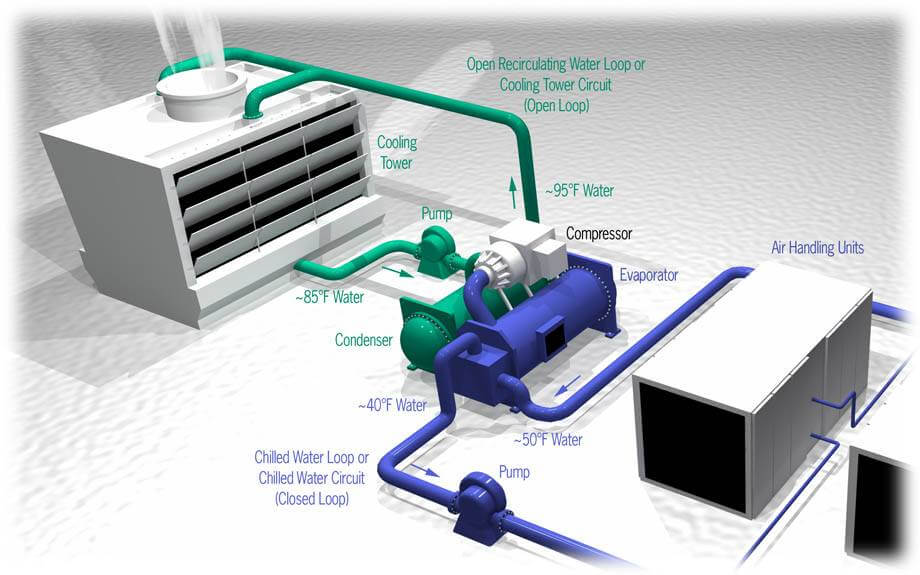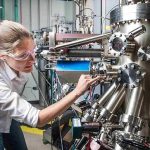System design determines the basic characteristics. After an air conditioning system is constructed according to the design, it is difficult and expensive to change the design concept.
Engineering Responsibilities
The normal procedure in a design-bid project includes the following steps and requirements:
1. Initiation of a construction project by owner or developer
2. Selection of design team
3. Setting of the design criteria and indoor environmental parameters
4. Selection of conceptual alternatives for systems and subsystems; preparation of schematic layouts of HVAC&R
5. Preparation of contract documents, working drawings, specifications, materials and construction methods, commissioning guidelines
6. Competitive bidding by contractors
7. Evaluation of bids; negotiations and modification of contract documents
8. Advice on awarding of contract
9. Review of shop drawings and commissioning schedule, operating and maintenance manuals
10. Monitoring, supervision, and inspection of construction
11. Supervision of commissioning: testing and balancing; functional performance tests
12. Modification of drawings to the as-built condition and the finalization of the operation and maintenance manual
13. Acceptance
Construction work starts at contract award following the bidding and negotiating and ends at the acceptance of the project after commissioning.
It is necessary for the designer to select among the available alternatives for optimum comfort, economics, energy conservation, noise, safety, flexibility, reliability, convenience, and maintainability. Experience, education, and judgment all enter into the selection process. If both a complicated system and a simple system yield the same performance, the simple system is preferred for its reliability, operator convenience, and lower cost.
Coordination between Air Conditioning and Other Trades, Teamwork
Air conditioning, plumbing, and fire protection systems are mechanical systems in a building. Both mechanical and electrical systems provide building services for the occupants and goods inside the building. Coordination between the mechanical engineer for HVAC&R and the architect, as well as between mechanical and structural or electrical engineers, or teamwork, becomes important. Factors requiring input from both the architect and the mechanical engineer include the following:
1. Shape and the orientation of the building
2. Thermal characteristics of the building envelope, especially the type and size of the windows and the construction of external walls and roofs
3. Location of the ductwork and piping to avoid interference with each other, or with other trades
4. Layout of the diffusers and supply and return grilles
5. Minimum clearance provided between the structural members and the suspended ceiling for the installation of ductwork and piping
6. Location and size of the rooms for central plant, fan rooms, duct and pipe shafts
If the architect makes a decision that is thermally unsound, the HVAC&R engineer must offset the additional loads by increasing the HVAC&R system capacity. Lack of such coordination results in greater energy consumption.
HVAC&R and other building services must coordinate the following:
1. Utilization of daylight and the type of artificial light to be installed
2. The layout of diffusers, grilles, return inlets, and light troffers in the suspended ceiling
3. Integration with fire alarm and smoke control systems
4. Electric power and plumbing requirements for the HVAC&R equipment and lighting for equipment rooms
5. Coordination of the layout of the ductwork, piping, electric cables, etc.
Retrofit, Remodelling, and Replacement
Retrofit of an HVAC&R system must be tailored to the existing building and integrated with existing systems. Each retrofit project has a motivation which may be related to environment, safety and health, indoor environment, energy conservation, change of use, etc. Because of ozone depletion, the production of CFCs ceased in the United States on January 1, 1996. All refrigeration systems using CFC refrigerants will be replaced by or converted to non-CFC refrigerant systems. For the sake of safety, smoke control systems and stairwell pressurization are items to be considered. For the sake of the occupants’ health, an increase in the amount of outdoor air may be the right choice. If energy conservation is the first priority, the following items are among the many that may be considered: efficiency of lighting; energy consumption of the fans, pumps, chillers, and boilers; insulation of the building envelope; and the remodeling or replacement of fenestration. For improving the thermal comfort of the occupant, an increase of the supply volume flow rate, an increase of cooling and heating capacity, and the installation of appropriate controls may be considered.
Engineer’s Quality Control
In 1988, the American Consulting Engineers Council chose “People, Professionalism, Profits: A Focus on Quality” as the theme of its annual convention in New York City. Quality does not mean perfection. In HVAC&R system design, quality means functionally effective, for health, comfort, safety, energy conservation, and cost. Quality also implies the best job, using accepted professional practices and talent. Better quality always means fewer complaints and less litigation. Of course, it also requires additional time and higher design cost. This fact must be recognized by the owner and developer.
The use of safety factors allows for the unpredictable in design, installation, and operation. For example, a safety factor of 1.1 for the calculated cooling load and of 1.1 to 1.15 for the calculated total pressure drop in ductwork is often used to take into account unexpected inferiority in fabrication and installation. An HVAC&R system should not be overdesigned by using a greater safety factor than is actually required. The initial cost of an overdesigned HVAC&R system is always higher, and it is energy-inefficient.
When an HVAC&R system design is under pressure to reduce the initial cost, some avenues to be considered are as follows:
1. Select an optimum safety factor.
2. Minimize redundancy, such as standby units.
3. Conduct a detailed economic analysis for the selection of a better alternative.
4. Calculate the space load, the capacity of the system, and the equipment requirements more precisely.
5. Adopt optimum diversity factors based on actual experience data observed from similar buildings.
A diversity factor is defined as the ratio of the simultaneous maximum load of a system to the sum of the individual maximum loads of the subdivisions of a system. It is also called the simultaneous-use factor. For example, in load calculations for a coil, block load is used rather than the sum of zone maxima for sizing coils for AHUs installed with modulating control for the chilled water flow rate.
The need for a higher-quality design requires that engineers have a better understanding of the basic principles, practical aspects, and updated technology of HVAC&R systems in order to avoid overdesign or underdesign and to produce a satisfactory product.
Design of the Control System
Controlling and maintaining the indoor environmental parameters within predetermined limits depends mainly on adequate equipment capacity and the quality of the control system. Energy can be saved when the systems are operated at part load with the equipment’s capacity following the system load accurately by means of capacity control.
Because of the recent rapid change of HVAC&R controls from conventional systems to energy management systems, to DDC with microprocessor intelligence, and then to open-protocol BACnet, many designers have not kept pace. In 1982, Haines did a survey on HVAC&R control system design and found that many designers preferred to prepare a conceptual design and a sequence of operations and then to ask the representative of the control manufacturer to design the control system. Only one-third of the designers designed the control system themselves and asked the representative of the control manufacturer to comment on it.
HVAC&R system control is a decisive factor in system performance. Many of the troubles with HVAC&R arise from inadequate controls and/or their improper use. The designer should keep pace with the development of new control technology. He or she should be able to prepare the sequence of operations and select the best-fit control sequences for the controllers from a variety of the manufacturers that offer equipment in the HVAC&R field. The designer may not be a specialist in the details of construction or of wiring diagrams of controllers or DDC modules, but he or she should be quite clear about the function and sequence of the desired operation, as well as the criteria for the sensors, controllers, DDC modules, and controlled devices.
If the HVAC&R system designer does not perform these duties personally, preparation of a systems operation and maintenance manual with clear instructions would be difficult. It would also be difficult for the operator to understand the designer’s intention and to operate the HVAC&R system.



Comments are closed